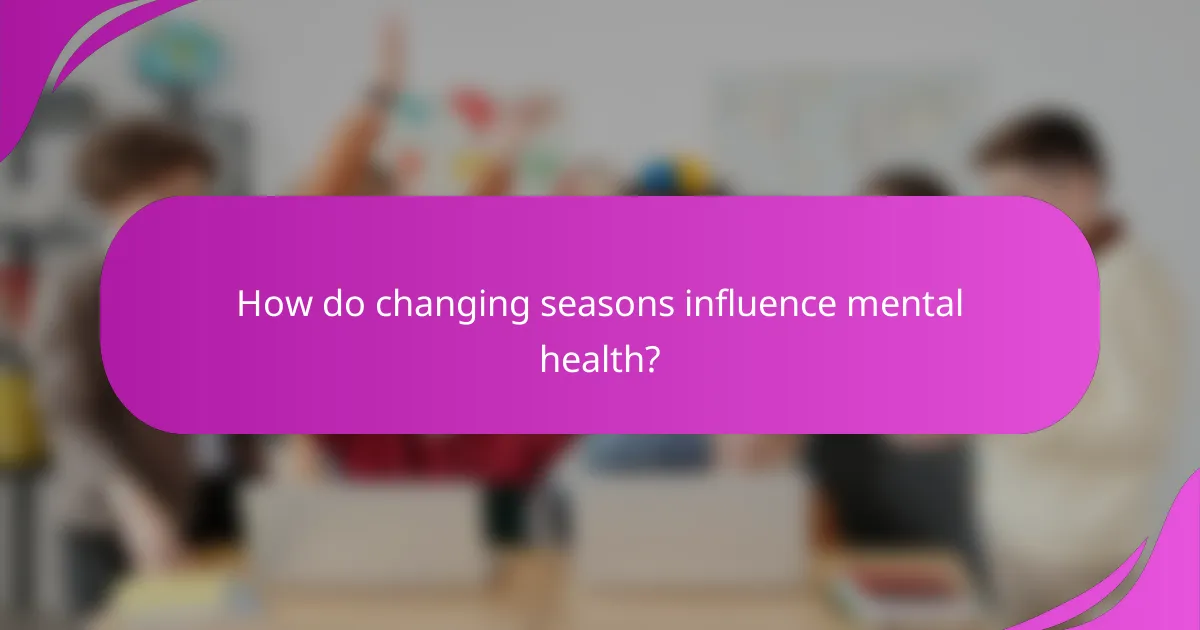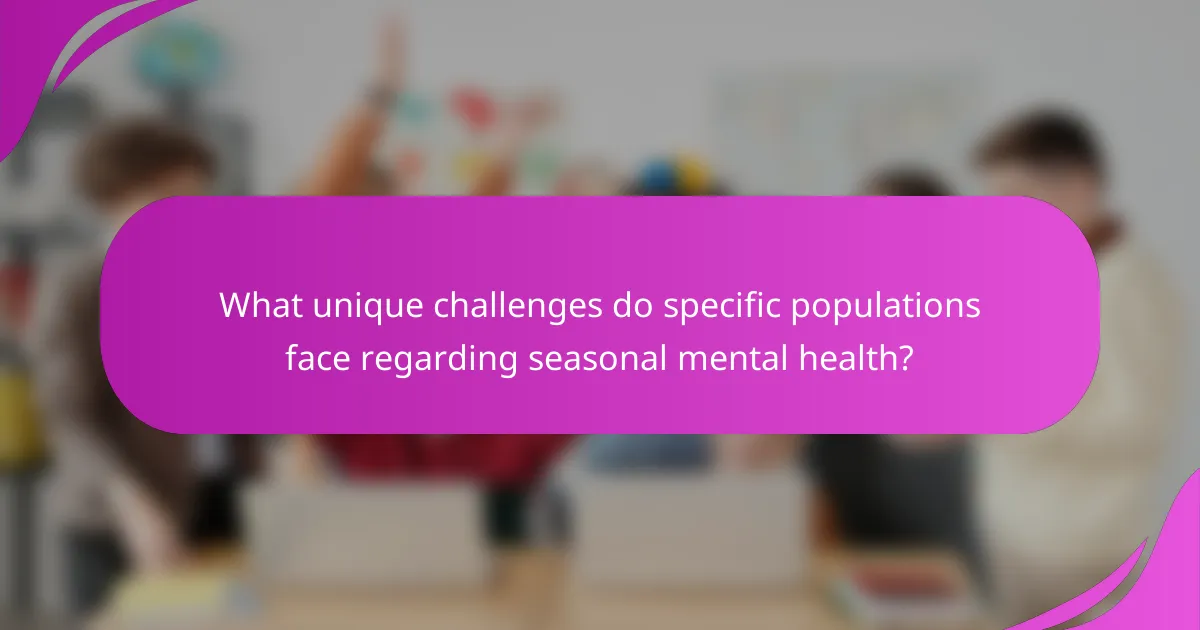Changing seasons can significantly impact mental health, leading to mood fluctuations and conditions like seasonal affective disorder. This article explores how variations in sunlight exposure affect serotonin levels, the coping strategies that can help maintain mental well-being, and the unique challenges faced by specific populations during seasonal transitions. Understanding these connections is essential for developing effective approaches to foster resilience and stability throughout the year.

How do changing seasons influence mental health?
Changing seasons significantly influence mental health, often leading to mood fluctuations and seasonal affective disorder. Seasonal changes can cause variations in sunlight exposure, impacting serotonin levels and overall well-being.
During spring and summer, increased sunlight can enhance mood and energy levels, promoting outdoor activities and social interactions. Conversely, fall and winter may bring shorter days, leading to feelings of sadness or lethargy.
Coping strategies include maintaining a regular routine, engaging in physical activity, and seeking natural light exposure. Additionally, therapy and support groups can provide essential assistance during challenging seasonal transitions.
Understanding the connection between seasons and mental health is crucial for developing effective coping mechanisms and fostering resilience.
What are the common mental health disorders affected by seasonal changes?
Seasonal changes commonly affect mental health disorders such as Seasonal Affective Disorder (SAD), anxiety, and depression. These conditions often worsen during winter months due to reduced sunlight and shorter days. Studies indicate that about 5% of adults experience SAD, characterized by depressive symptoms that align with seasonal patterns. Coping strategies include light therapy, regular exercise, and maintaining social connections to mitigate these effects.
How do seasonal affective disorder and depression relate?
Seasonal affective disorder (SAD) is a type of depression linked to seasonal changes. Both conditions share symptoms such as low energy and mood changes, indicating a strong relationship. Seasonal changes can trigger episodes of depression, particularly in winter months when daylight decreases. Coping strategies for both include light therapy, exercise, and maintaining social connections, which can mitigate symptoms effectively.
What are the symptoms of seasonal affective disorder?
Seasonal affective disorder (SAD) symptoms include persistent sadness, fatigue, changes in sleep patterns, and difficulty concentrating. These symptoms often emerge during fall and winter months, coinciding with reduced sunlight. Individuals may also experience weight gain, social withdrawal, and feelings of hopelessness. Recognizing these symptoms is crucial for effective coping strategies.
What are the risk factors for developing seasonal affective disorder?
Seasonal affective disorder (SAD) risk factors include a family history of mood disorders, living far from the equator, and a lack of sunlight exposure. Other factors are age, with younger individuals more susceptible, and gender, as women are more likely to develop SAD than men. Additionally, pre-existing mental health issues can increase vulnerability.
What physiological mechanisms link seasons to mental health?
Seasonal changes significantly impact mental health through biological and environmental mechanisms. These include variations in sunlight exposure, which affect serotonin levels, and fluctuations in temperature, influencing mood and energy. Seasonal Affective Disorder (SAD) exemplifies these effects, as symptoms often worsen during winter months due to reduced daylight. Coping strategies like light therapy and increased outdoor activity can mitigate these seasonal impacts, promoting better mental health year-round.
How does daylight exposure impact mood regulation?
Daylight exposure significantly enhances mood regulation by increasing serotonin levels. Seasonal changes can lead to variations in sunlight, affecting mental health. For example, longer days in summer boost energy and happiness, while shorter days in winter may contribute to seasonal affective disorder. Research shows that individuals exposed to natural light experience lower rates of depression and anxiety. Coping strategies during darker months can include light therapy and outdoor activities to maximize daylight exposure.
What role does temperature play in emotional well-being?
Temperature significantly influences emotional well-being by affecting mood and mental health. Seasonal changes can lead to variations in temperature, impacting energy levels and emotional states. For instance, colder months often correlate with increased feelings of sadness or depression, while warmer temperatures may enhance positivity and motivation. Research indicates that exposure to sunlight boosts serotonin levels, which can improve mood and alleviate symptoms of Seasonal Affective Disorder (SAD). As a result, adapting coping strategies to seasonal temperature changes is essential for maintaining mental health.

What coping strategies can help manage seasonal mental health challenges?
Engaging in coping strategies can effectively manage seasonal mental health challenges. These strategies include maintaining a routine, exercising regularly, and seeking social support. Additionally, exposure to natural light and practicing mindfulness can enhance mood stability. Implementing these techniques can mitigate the impact of seasonal changes on mental well-being.
How can lifestyle changes improve mental health during different seasons?
Lifestyle changes can significantly enhance mental health throughout different seasons by promoting stability and resilience. Seasonal affective disorder (SAD) often peaks in winter, making light exposure and outdoor activities crucial. Engaging in regular exercise, maintaining a balanced diet, and practicing mindfulness can alleviate symptoms across all seasons.
As seasons shift, adjusting routines to include seasonal activities can foster a sense of purpose. For example, summer can encourage social interactions, while winter may benefit from cozy indoor hobbies. Adapting to seasonal changes through proactive lifestyle modifications can improve overall mental well-being.
Research indicates that individuals who embrace seasonal changes with intentional lifestyle adjustments report better mental health outcomes. These strategies can include setting seasonal goals, participating in community events, and prioritizing self-care practices tailored to each season’s unique challenges.
What are effective exercise routines for seasonal mental health?
Effective exercise routines for seasonal mental health include outdoor activities, strength training, and mindfulness exercises. Engaging in nature walks during spring or summer boosts mood and reduces anxiety. Strength training enhances self-esteem and combats winter blues. Mindfulness exercises, such as yoga, promote emotional balance year-round. Incorporating these routines can significantly improve mental health as seasons change.
How does nutrition affect mood throughout the year?
Nutrition significantly influences mood throughout the year by providing essential nutrients that affect brain chemistry. Seasonal changes can impact food availability and dietary habits, which in turn affects mental health. For example, during winter months, people may consume fewer fruits and vegetables, leading to deficiencies in vitamins that support mood regulation. As a result, incorporating seasonal produce can enhance mood stability. Unique attributes, such as omega-3 fatty acids found in fatty fish, have been linked to reduced symptoms of depression, highlighting the importance of specific nutrients in maintaining mental well-being across seasons.
What therapeutic approaches are effective for seasonal mental health issues?
Cognitive-behavioral therapy, mindfulness practices, and light therapy are effective therapeutic approaches for seasonal mental health issues. Cognitive-behavioral therapy helps individuals identify and alter negative thought patterns associated with seasonal changes. Mindfulness practices, such as meditation, promote awareness and acceptance of emotions, reducing anxiety and depression. Light therapy, particularly for seasonal affective disorder, involves exposure to bright light to counteract seasonal mood changes. Each approach addresses unique attributes of seasonal mental health challenges, offering tailored coping strategies.
How can cognitive-behavioral therapy assist with seasonal affective disorder?
Cognitive-behavioral therapy (CBT) effectively helps individuals manage seasonal affective disorder (SAD) by addressing negative thought patterns. CBT teaches coping strategies that improve mood and motivation during seasonal changes. Research shows that CBT can reduce symptoms of SAD by up to 50%. This therapy focuses on identifying and reframing negative thoughts, promoting behavioral activation, and enhancing problem-solving skills. As a result, individuals can develop healthier responses to seasonal changes and improve overall mental well-being.
What role does light therapy play in managing seasonal depression?
Light therapy effectively alleviates symptoms of seasonal depression by mimicking natural sunlight. This treatment helps regulate circadian rhythms and boosts serotonin levels, improving mood. Studies show that light therapy can reduce depression severity in 60-80% of patients. Typically, sessions last 20-30 minutes daily, using specialized light boxes that filter UV rays. Consistent use during darker months enhances emotional well-being and offers a non-pharmaceutical option for managing seasonal affective disorder.

What unique challenges do specific populations face regarding seasonal mental health?
Specific populations face unique challenges regarding seasonal mental health, including increased anxiety and depression during specific seasons. For instance, individuals with Seasonal Affective Disorder (SAD) experience significant mood changes as daylight hours decrease.
Elderly populations may struggle with isolation during winter months, impacting their mental well-being. Adolescents often face academic pressures that can intensify during back-to-school seasons.
Cultural factors also play a role; certain communities may experience heightened stress during holidays due to family expectations. Understanding these unique challenges is essential for developing effective coping strategies tailored to each population’s needs.
How do seasonal changes affect mental health in children and adolescents?
Seasonal changes significantly impact mental health in children and adolescents, often leading to mood fluctuations and increased anxiety. Research indicates that shorter daylight hours can contribute to feelings of sadness and lethargy.
During winter months, reduced sunlight exposure may lead to Seasonal Affective Disorder (SAD), which affects children’s energy levels and motivation. Conversely, spring and summer often bring improved moods and increased activity, fostering better mental health.
Coping strategies such as maintaining a routine, engaging in outdoor activities, and ensuring adequate social interaction can mitigate these effects. Parents and caregivers should monitor changes in behavior and provide support during transitions between seasons.
Understanding these seasonal influences is crucial for promoting mental well-being in young individuals.
What considerations are there for elderly individuals during seasonal transitions?
Elderly individuals may experience heightened sensitivity to seasonal changes, impacting their mental health. Factors to consider include changes in sunlight exposure, which can affect mood and lead to seasonal affective disorder. Social isolation often increases during colder months, necessitating strategies to maintain social connections. Physical health concerns may also arise, as fluctuating temperatures can exacerbate chronic conditions. It is crucial to promote coping strategies such as engaging in regular physical activity, maintaining a balanced diet, and seeking support from community resources.

What are the best practices for maintaining mental health year-round?
Changing seasons can significantly impact mental health, necessitating proactive coping strategies. To maintain mental health year-round, consider these best practices:
1. **Stay Active**: Regular physical activity boosts mood and alleviates anxiety. Aim for at least 150 minutes of moderate exercise weekly.
2. **Maintain a Routine**: Consistent daily schedules help regulate mood and provide structure, especially during seasonal transitions.
3. **Connect with Nature**: Spend time outdoors to benefit from natural light and fresh air, which can enhance well-being.
4. **Practice Mindfulness**: Engage in mindfulness techniques, such as meditation or yoga, to reduce stress and increase emotional resilience.
5. **Seek Social Support**: Foster relationships with friends and family to create a supportive network that can help during challenging times.
6. **Adjust Diet**: Nutritional choices can influence mood. Incorporate a balanced diet rich in fruits, vegetables, and omega-3 fatty acids.
Implementing these strategies can help mitigate the seasonal effects on mental health and promote overall well-being.
How can individuals create a supportive environment for mental wellness?
Individuals can create a supportive environment for mental wellness by fostering connection, understanding, and resources. Establishing open communication encourages sharing feelings and experiences. Incorporating nature, particularly during seasonal changes, enhances mood and reduces stress. Engaging in community activities builds a sense of belonging and support. Providing access to mental health resources, such as counseling and workshops, empowers individuals to seek help. Additionally, practicing mindfulness and promoting healthy habits like exercise and nutrition can further enhance mental well-being.
What common mistakes should be avoided in seasonal mental health management?
To manage seasonal mental health effectively, avoid neglecting self-care, dismissing the impact of seasonal changes, and failing to seek professional help when needed. Recognize that changes in light and routine can significantly affect mood and energy levels. Establishing consistent coping strategies, such as regular exercise and social interactions, is crucial.
What expert insights can enhance coping strategies for seasonal changes?
Expert insights suggest that adapting coping strategies for seasonal changes can significantly enhance mental well-being. Seasonal Affective Disorder (SAD) affects many individuals, particularly during winter months. Engaging in regular outdoor activities, even in colder weather, can improve mood and energy levels.
Mindfulness practices, such as meditation and yoga, help manage stress and anxiety associated with seasonal transitions. Additionally, maintaining a balanced diet rich in omega-3 fatty acids and vitamin D can support mental health.
Establishing a routine that includes physical exercise and social interactions fosters resilience against seasonal mood fluctuations. Embracing hobbies and interests can provide a sense of purpose and joy throughout the year.



